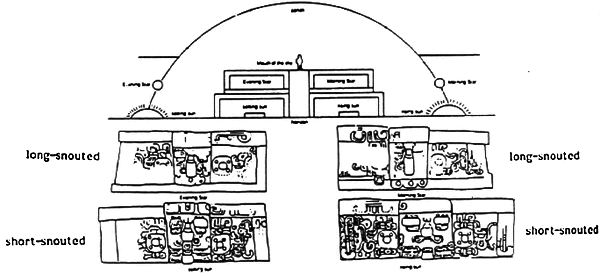| home | Sixth Round Table: Olmec Influence |

|
The identification of elements of the Olmec inconographic system with the later Maya art should be predicated on the testable hypothesis that certain elements of the Maya system can be visually identified in the Olmec system and that these elements perform similar functions in both systems. One obvious link between these two systems is the use of large stone and/or plaster masks as billboards for the display of symbolic information. The Maya were constructing architectural facades that displayed such masks between 150 B.C. and 50 B.C. at the Late Formative Period sites of Mirador, Uaxactún, and Cerros. On the Pacific Coast at Tzutzuculi, a Middle Formative site with strong inconographic links to the Olmec "heartland", similar facade masks, executed in the Olmec style, were erected by 650 B.C. (MacDonald 1983:37). At the above-mentioned Maya sites large, multitiered buildings were constructed with elaborate zoomorphic masks placed on either side of a central staircase. At the site of Cerros, in particular, four zoomorphic masks, two of which are blunt-snouted and two long-snouted are so positioned on Structure 5c-2nd that they symbolically replicate the daily course of the sun (figure 1a). Linda Schele and Mary Miller have demonstrated (1986:106) that this pyramid with its facade masks served as a stage for the public demonstration of the supernatural power of the Cerros ruler. |
|
Photo: Werner Forman/Art Resource, NY. |
| home | Sixth Round Table: Olmec Influence |